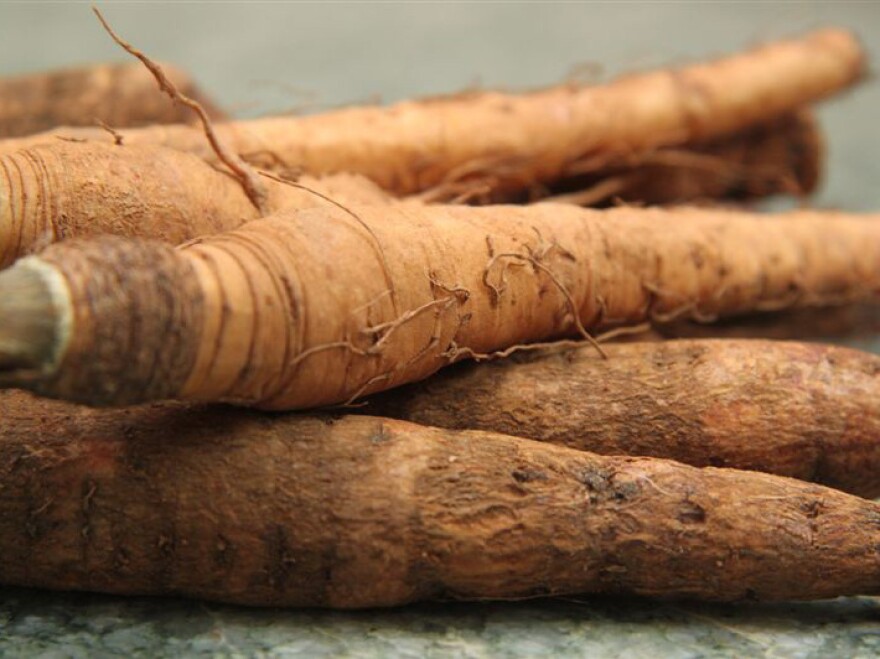The young man at the supermarket checkout counter looked puzzled. "You have a lot of obscure things in here," he said, nodding at my basket. He didn't know any of the codes for such ambiguous items as salsify, Jerusalem artichoke, rutabaga or jicama.
Even inexperienced cooks know what a carrot or potato looks like. More "obscure" root vegetables are not so easy to recognize, though, and some of them look a lot alike — you know, all those unlabeled brown tubers and knobby spheres in a separate case in the middle of the produce section.
If we're going to try to eat locally, however, root vegetables are about it for the winter harvest. There won't be much growing aboveground until spring.
What lies beneath the surface is an underappreciated bounty. Beets, carrots, turnips, parsnips and radishes are at least vaguely familiar. Until the second half of the 20th century, salsify, Jerusalem artichokes and their obscure fellows were common, too.
Before refrigerated trucks, airplanes and greenhouses, there was no baby bok choy in the winter in most parts of the country. People stored roots to eat until the first shoots of spring.
For centuries, Native Americans ate wild roots and tubers through the cold weather. They ate the nutritious roots of the aquatic arrowhead plant, baked and ground dandelion roots into a powder to brew like coffee, made flour out of cattail roots. They used day lily tubers like corn and cooked with the peppery taproots of the evening primrose. Most of these still exist only in the wild.
The colonists were so taken with some of the roots they saw the Indians eat that they began to plant them in gardens. They liked Jerusalem artichokes so much they took them to Europe, one of the few North American native plants to be taken to the Old World. The crunchy, water chestnut-like tuber with the mild flavor was very trendy in France in the 1600s. It has been in and out of fashion in both old and new worlds ever since.
Jerusalem artichokes are tubers that grow from the roots of a sunflower, and are connected neither to Jerusalem nor the artichoke. One common explanation is that "Jerusalem" is a corruption of girasole, the Italian word for sunflower. Somewhere in its travels, its flavor was compared to that of an artichoke. Native Americans called them sun roots — much less confusing.
I read about salsify years ago but was never able to find it — until this year. It, too, seems to be making a tiny comeback. Salsify, which food writer Elizabeth Schneider has described as looking like "a petrified carrot," was once common in American gardens and kitchens. Thomas Jefferson planted loads of salsify, and old American cookbooks often contain salsify recipes.
Remember, beauty is only skin deep. Beneath their homely exteriors, root vegetables have a lot to offer. Served on their own or mixed with more common sweet potatoes, beets, parsnips and carrots, newly fashionable root vegetables add flavor, color and texture to the winter pot.
New waves of immigration have brought jicama from Mexico, yucca from Central America and the Caribbean and daikon radishes from Asia. No doubt, we'll dig up even more. There may even come a time when these and other roots and tubers no longer seem obscure at the supermarket.

Obscure Root Vegetables
Celery Root. Also called celeriac or knob celery. Celery root has a milder, sweeter flavor than its cousin, cultivated celery. The gnarled root is ugly, dirty and a pain to peel. It is, however, worth the effort. Celery root can be grated raw in salads, julienned and tossed with mayonnaise for the common French celeri en remoulade, served as a puree, roasted or used in soups (I always use it — and a lot of other root vegetables — when making chicken soup). It has an earthy, slightly sweet celery flavor and is available from fall to early spring

Jerusalem Artichokes. Also called sun chokes, these tubers look a little like ginger. They have been bred to be less knobby and more smooth-skinned then their wild relatives. They don't have to be peeled and can be eaten raw in salads, parboiled and pickled, roasted, baked, creamed or fried — anything you can do with a potato. They have the crunch of a water chestnut and a mild flavor. They are sweetest from fall through winter.
Jicama. This Mexican tuber has become more common in the U.S. in recent years and is now grown in parts of the country. The round, flat ball can be eaten raw or cooked in both savory and sweet foods. It has the wonderful crunch of the water chestnut for which it is sometimes substituted.
Rutabaga. Called Swedes by the English, rutabagas are closely related to turnips. They are round and waxy, and their sweet yellow flesh turns orange after cooking. They probably originated in central Europe and reached the U.S. in the beginning of the 19th century. The word rutabaga is a corruption of the Swedish dialect for a bulbous shape.

Salsify. This root looks like a slim, blackened carrot or parsnip. It has traditionally been hard to find in the U.S. but was seen in cookbooks through the mid-1940s. It has long been popular in France, where it is sometimes called oyster plant for a purported oysterlike flavor. Under the barklike skin is mild white flesh that must be plunged into water and lemon juice after peeling to avoid discoloration. Salsify can be steamed and covered with a light bechamel or cheese sauce, dressed in a vinaigrette, pureed as a soup or added to other soups and stews. Fall and winter are the height of its season.
Copyright 2023 NPR. To see more, visit https://www.npr.org.


